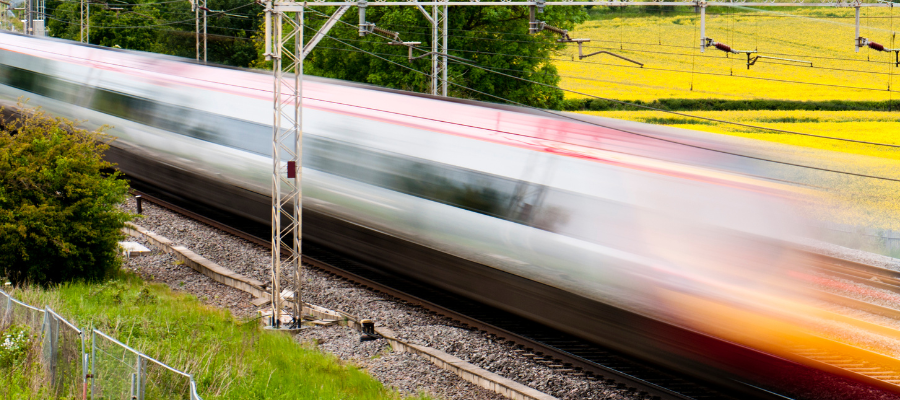🕒 Article read time: 2 minutes
Further delays for HS2 impede rail freight growth

Rail continues to play its part in decarbonising freight, paving the way for the UK to reach its targets for achieving net zero by 2050.
Driving modal shift towards low-carbon freight improves air quality and reduces road congestion particularly in urban areas, and it is estimated that rail freight removes 1,000 HGV movements per day from London’s roads alone. Rail is vital for supporting the construction of major infrastructure projects, carrying waste from urban areas for conversion into renewable energy and moving containerised consumer products through London and across Britain.
HS2 SET TO RELEASE RAIL CAPACITY FOR FREIGHT
High Speed Two (HS2), Britain’s new high-speed rail line between London and the north west, was expected to lead to a significant increase in network capacity and investment to deliver growth.
Ellis Shelton, Policy Advisor, Logistics UK, said: “This project has the potential to transform the rail network and provide the economy with a much-needed financial boost.”
Currently, there are over 350 active sites between the West Midlands and London, supporting jobs and delivering benefits before a single train has started running.
“It is therefore a blow to the industry,” Shelton said, “that the UK government has announced a further delay, with elements of the project already cancelled or postponed indefinitely.”
INFLATIONARY PRESSURES AND SOARING COSTS
The main London-Birmingham stretch is now set to be delayed by a further two years as a “rephase construction” initiative, owing to many setbacks caused by inflationary pressure and increased project costs. With the first train now not scheduled to operate until 2033, rail freight operators have been quick to criticise the delay, following Transport Secretary Mark Harper’s announcement on 9 March 2023, stating there is little gain for rail freight capacity given the additional wait time and unpredictability around the Crewe and Manchester expansions (Phases 2a and 2b). This delay is expected to significantly affect the amount of capacity that will be available, particularly if new HS2 lines are to be forced to run on the existing tracks, as the West Coast Main Line is the most important route for rail freight in the country.
GREATER UNCERTAINTY = DIMINISHING RETURNS
With the deadline being extended once again, rail freight businesses, which are supporting the construction of HS2 by supplying materials and engineering services, are now facing uncertainty. The broader benefits of the overall scheme are also at risk of being significantly reduced.
“The potential benefits of HS2 are diminishing as government continues to reduce the scope, by abandoning longer routes and delivery dates being extended,” Shelton said, “Government must consider the repercussions this decision will have on the rail freight sector and find a way forward which supports it as HS2 is critical in terms of freeing up capacity for freight on the network.”
NEED FOR INTEGRATED INFRASTRUCTURE
Recently, Logistics UK has highlighted to the Chancellor, Jeremy Hunt, and the Labour Party, that the UK needs innovative and integrated infrastructure to enable the sector to deliver an increasingly productive and strategic logistics network. This will support economic growth by keeping costs on shelves down and reducing emissions.
“To cement rail freight’s position within reliable, sustainable supply chains across the country, industry needs government to set an ambitious rail freight target,” Shelton said.
New analysis calls for rail freight to treble by 2050, delivering £5.2 billion in economic benefits every year and taking 20 million HGV journeys off the roads which would help with road congestion relief and air quality improvement.
INCREASING NATIONAL NETWORK CAPACITY
If rail freight is to meet the needs of modal shift and dramatically expand traffic, significant capacity augmentation on the national network is required. Logistics UK argues that this should include delivering investment in rail to increase the capacity for freight, such as through HS2 and making more strategic decisions on existing capacity, where Network Rail and Great British Railways (GBR) support is needed.
“Government needs to set out long-term infrastructure plans and reforming planning to unlock private sector investment in rail freight,” Shelton said, “such as the inland freight terminals that enable the road and rail networks to work as one, supporting modal shift.”
REFORMING THE RAILWAYS
The government’s desire to reform the railways has been evidenced by recent key announcements. In February, the Transport Secretary set out a long-term freight growth target this year in his Bradshaw address. On 21 March, Derby was selected by government to be the new home and national headquarters of Great British Railways (GBR) following its demonstration of strong links to the wider network, well-established connections with the industry, supply chain and customers, as well as an extensive local cluster of private sector rail businesses. As Europe’s largest rail hub, Derby will soon become the heart of Great Britiain’s rail industry too, bringing track and train together and delivering high-skilled jobs to the region.
“It is vital that government collaborates with the private rail freight sector to achieve the ambitious goal of tripling freight,” Shelton said, “For the freight sector to expand and become carbon-free, freight operators and their clients will need to make investments in new resources and infrastructure, as a growing rail freight market has the potential to deliver even greater economic and environmental benefits between now and 2050. Logistics UK will continue to work with government on maximising the benefits of rail freight advancements and support members along the way.”
*www.logistics.org.uk/rail
Published On: 20/04/2023 16:00:00

Comments Section
If you are a Logistics UK member login to add comments.